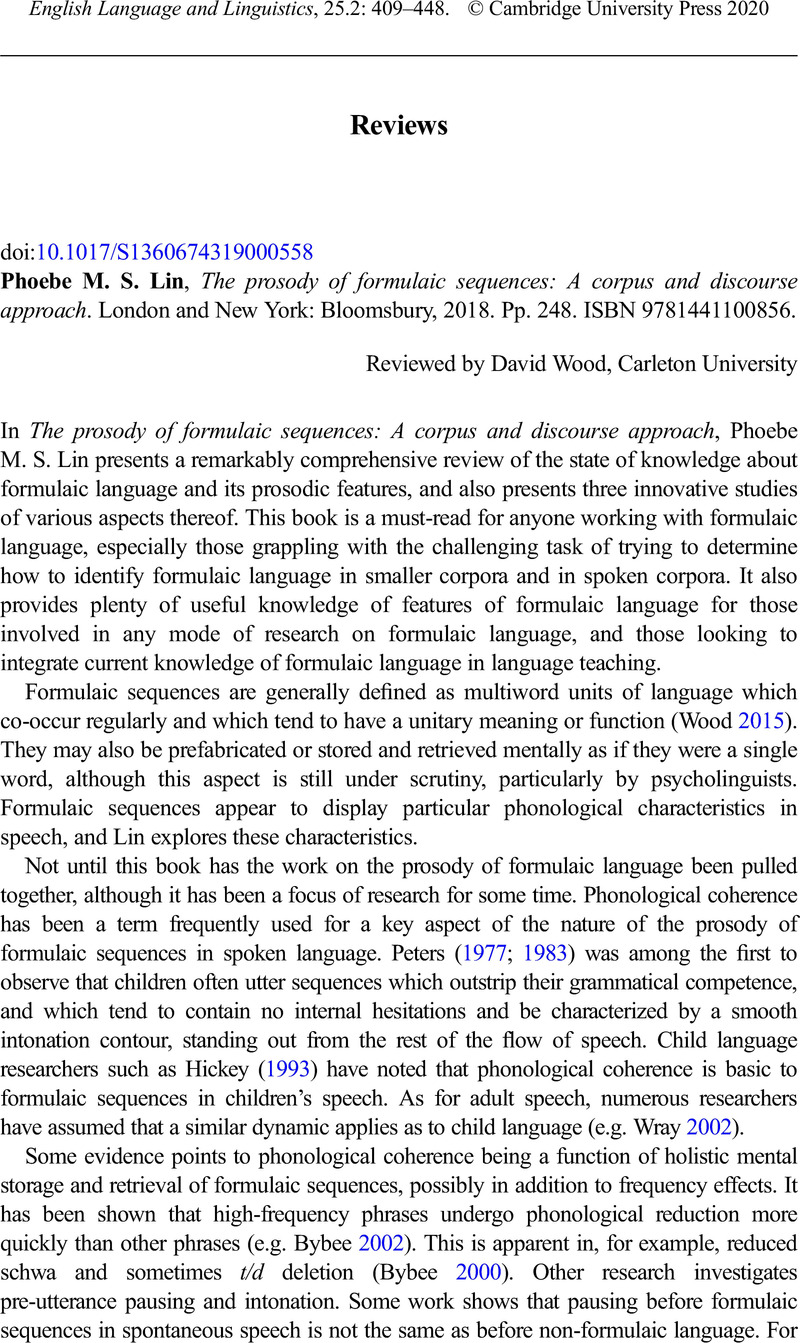No CrossRef data available.
Article contents
Phoebe M. S. Lin, The prosody of formulaic sequences: A corpus and discourse approach. London and New York: Bloomsbury, 2018. Pp. 248. ISBN 9781441100856.
Review products
Phoebe M. S. Lin, The prosody of formulaic sequences: A corpus and discourse approach. London and New York: Bloomsbury, 2018. Pp. 248. ISBN 9781441100856.
Published online by Cambridge University Press: 31 March 2020
Abstract
An abstract is not available for this content so a preview has been provided. Please use the Get access link above for information on how to access this content.

- Type
- Book Review
- Information
- Copyright
- Copyright © Cambridge University Press 2020
References
Bybee, Joan. 2000. The phonology of the lexicon. In Barlow, Michael & Kemmer, Suzanne (eds.), Usage-based models of language, 65–85. Stanford, CA: CSLI Publications.Google Scholar
Bybee, Joan. 2002. Phonological evidence for exemplar storage of multiword sequences. Studies in Second Language Acquisition 24, 215–21.CrossRefGoogle Scholar
Erman, Britt. 2007. Cognitive processes as evidence of the idiom principle. International Journal of Corpus Linguistics 12(1), 25–53.CrossRefGoogle Scholar
Hickey, Tina. 1993. Identifying formulas in first language acquisition. Journal of Child Language 20, 27–41.CrossRefGoogle ScholarPubMed
Hudson, Jean & Wiktorsson, Maria. 2009. Formulaic language and the relater category – the case of about. In Corrigan, Roberta, Moravcsik, Edith A., Ouali, Hamid & Wheatley, Kathleen M. (eds.), Formulaic language, vol. 1: Distribution and historical change, 77–96. Amsterdam: John Benjamins.CrossRefGoogle Scholar
Lin, Phoebe Min Sum. 2010. The phonology of formulaic sequences: A review. In Wood, David (ed.), Perspectives on formulaic language: Acquisition and communication, 174–93. New York and London: Continuum.Google Scholar
Lin, Phoebe Min Sum & Adolphs, Svenja. 2009. Sound evidence: Phraseological units in spoken corpora. In Barfield, Andy & Gyllstad, Henrik (eds.), Researching collocations in another language: Multiple interpretations, 34–48. Basingstoke: Palgrave Macmillan.CrossRefGoogle Scholar
Peters, Ann M. 1977. Language learning strategies: Does the whole equal the sum of the parts? Language 53(3), 560–73.CrossRefGoogle Scholar
Peters, Ann M. 1983. Units of language acquisition. Cambridge: Cambridge University Press.Google Scholar
Wood, David. 2015. Fundamentals of formulaic language: An introduction. London and New York: Bloomsbury.Google Scholar
Wray, Alison. 2002. Formulaic language and the lexicon. Cambridge: Cambridge University Press.CrossRefGoogle Scholar
Wulff, Stefanie. 2008. Rethinking idiomaticity: A usage-based approach. London and New York: Continuum.Google Scholar



